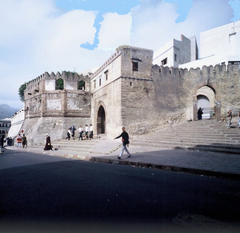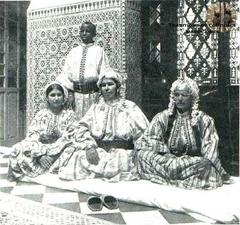Bab Saida Visiting Hours, Tickets, and Historical Sites in Tétouan, Morocco
Date: 14/06/2025
Introduction: Bab Saida and Its Cultural Significance
Bab Saida stands as a distinguished gateway to the Medina of Tétouan, a UNESCO World Heritage Site in northern Morocco. This historic gate is more than just an architectural landmark; it is a vibrant symbol of Tétouan’s multicultural legacy, reflecting Andalusian, Arab, Berber, Jewish, and Spanish influences. Originally constructed in the 15th century during the Merinid dynasty, Bab Saida played a pivotal role in connecting the medina with the fertile Rif region, fostering trade, cultural exchange, and community interaction. Its architectural elements—such as the classic horseshoe arch, carved wooden doors, and intricate zellij tilework—attest to the city’s Andalusian heritage and the craftsmanship of refugees who settled after the fall of Granada in 1492. Today, Bab Saida remains a central hub, serving as a passageway for locals and visitors and as a focal point for festivals, artisan activity, and guided explorations (UNESCO, Visit Morocco, Mad Traveller).
Table of Contents
- Introduction
- Historical Context of Bab Saida
- Architectural Significance
- Visiting Bab Saida: Practical Information
- Cultural and Symbolic Importance
- FAQs
- Conclusion
- References
Historical Context of Bab Saida
Origins and Urban Development
Bab Saida is one of Tétouan’s seven historical gates, integral to the medina’s fortified walls built during the Merinid dynasty (UNESCO). The walls, stretching roughly 5 kilometers, were designed to safeguard the city and manage the flow of commerce and people. Positioned on the eastern side, Bab Saida connected Tétouan to rural agricultural lands and essential trade routes.
Following the 1492 fall of Granada, waves of Andalusian Muslims and Jews entered through gates like Bab Saida, bringing advanced urban planning and distinctive architectural styles. Their influence transformed Bab Saida from a defensive structure into a symbol of Tétouan’s cosmopolitan identity (Visit Morocco).
Social and Economic Role
Historically, Bab Saida was a vital access point for merchants, artisans, and travelers, facilitating the exchange of goods between the medina and the Rif region. Its proximity to artisan quarters and markets made it a hub for daily life, especially during market days and religious festivities (Wikivoyage).
Architectural Significance
Structural Features and Decorative Elements
Bab Saida exemplifies Tétouan’s architectural elegance. Built from local stone and lime, the gate features a robust horseshoe arch, decorative geometric motifs, and calligraphic inscriptions inspired by Andalusian and Moorish designs. Notable details include:
- Horseshoe Arch: A hallmark of Islamic and Andalusian architecture.
- Carved Wooden Doors: Decorated with metal studs, demonstrating traditional craftsmanship.
- Stucco and Zellij Tilework: Remnants of intricate mosaics and stucco showcase Andalusian aesthetics (Top Morocco).
Integration with Medina Fortifications
Bab Saida seamlessly integrates into the medina’s ramparts, which include six other gates such as Bab Oqla and Bab Toute (Visit Morocco). Its thick walls and narrow passageways balanced defense with accessibility, while ornamentation signaled the city’s prosperity.
Andalusian and Spanish Influences
The gate’s design reflects the influence of Andalusian refugees who introduced building techniques and motifs from Seville and Granada. Despite the Spanish Protectorate era (1913–1956) layering European styles onto the city, Bab Saida preserved its historic form, linking Tétouan to its pre-colonial roots (Kurby Blog).
Visiting Bab Saida: Practical Information
Visiting Hours and Tickets
- Bab Saida: Open to the public 24/7, with no entrance fee.
- Nearby Historical Sites: Museums and cultural sites in the medina (e.g., Ethnographic Museum, Dar El Oddi) typically open from 9:00 AM to 5:00 PM and may charge entrance fees ranging from 20–50 MAD (Pin Your Footsteps).
Accessibility
The gate area features uneven cobblestone streets and narrow alleys, which may pose challenges for visitors with mobility impairments. Comfortable footwear is recommended.
Guided Tours and Travel Tips
Hiring a licensed local guide is recommended for in-depth historical context. Guided tours start or end at Bab Saida and cover the medina’s highlights. For independent exploration, download offline maps and allow time for spontaneous discoveries (Lonely Planet).
Safety and Etiquette
- Dress modestly, covering shoulders and knees, especially near religious sites.
- Avoid photographing people without permission.
- Keep valuables secure and be aware of pickpockets in crowded areas (Local Adventurer).
Facilities
Public facilities near Bab Saida are limited. Guesthouses such as Dar Rehla provide amenities like Wi-Fi and air conditioning (Booking.com). Public restrooms are scarce, so plan accordingly.
Key Nearby Attractions
- Medina of Tétouan: A UNESCO World Heritage Site, accessible directly from Bab Saida (UNESCO).
- Ethnographic Museum: Housed in a 19th-century fortress, featuring traditional artifacts and panoramic rooftop views (revigorate.com).
- Dar El Oddi: A restored riad with exhibitions on Tétouan’s history (revigorate.com).
- Feddan Park: A tranquil green space with a café and scenic medina views (revigorate.com).
- Riyad Al Ochak: An Arab-Andalusian garden ideal for relaxation (revigorate.com).
- Tétouan Museum of Modern Art: Showcasing Moroccan, Spanish, and Andalusian works (revigorate.com).
- Day Trips: Easily access Chefchaouen, Martil, and Tamuda Bay for contrasting experiences (wildtrips.net, visitmorocco.com).
Cultural and Symbolic Importance
Bab Saida is not only a gateway but also a symbol of Tétouan’s multicultural coexistence and resilience. Its proximity to the Mellah (Jewish quarter) and religious sites like the zaouïa of Sidi Saidi underscores its role in the city’s spiritual and communal life. The gate hosts processions and festivals, serving as a gathering place for both residents and visitors (Mad Traveller).
Preservation efforts by local authorities and international organizations, guided by principles of authenticity and sustainability, ensure Bab Saida remains a vibrant part of Tétouan’s urban fabric (UNESCO).
Frequently Asked Questions (FAQs)
Q: Is there an entrance fee for Bab Saida?
A: No, Bab Saida is a public gate and free to visit at any time.
Q: What are the best times to visit Bab Saida?
A: Early morning or late afternoon for optimal lighting, fewer crowds, and cooler temperatures.
Q: Are guided tours available?
A: Yes, local guides offer tours starting or ending at Bab Saida.
Q: Is Bab Saida wheelchair accessible?
A: The area has uneven streets, making accessibility difficult for wheelchairs.
Q: What attractions are near Bab Saida?
A: The Ethnographic Museum, Dar El Oddi, Feddan Park, and artisan workshops in the medina.
Conclusion
Bab Saida is a cornerstone of Tétouan’s historical and cultural identity—an open, freely accessible monument that offers a window into centuries of intercultural evolution. From its distinctive Andalusian architecture to its role in the city’s daily and spiritual life, Bab Saida invites travelers to explore the rich heritage of the medina and the broader Tétouan region. For a memorable and enriching visit, plan your route, consider a guided tour, and use reliable resources like the Audiala app for up-to-date information. Embrace the opportunity to walk through Bab Saida and experience the living history of one of Morocco’s most enchanting cities.
References
- UNESCO World Heritage Centre: Medina of Tetouan (formerly known as Titawin)
- Visit Morocco: Tétouan Guide
- Mad Traveller: Medina of Tétouan
- Guidedumaroc.fr: Visiter la Médina de Tétouan
- Pin Your Footsteps: Tétouan Travel Guide
- Revigorate: Things to Do in Tétouan
- Top Morocco: Tétouan City Guide
- The Flyaway Girl: Things to Do in Tétouan
- Kurby Blog: The Evolution of Tétouan’s Architecture
- Booking.com: Dar Rehla
- Lonely Planet: Morocco Travel Tips
- Local Adventurer: Morocco Travel Tips
- Wildtrips.net: Tétouan Top Attractions
- touristplaces.guide: Top 10 Places to Visit in Tétouan
- moroccanscene.com: Tétouan – The Mountain Jewel City

